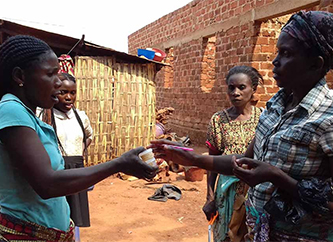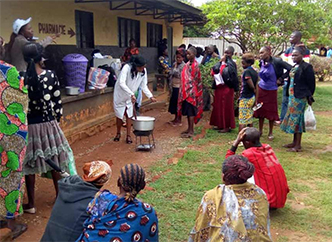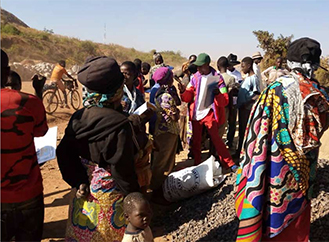consent_cookie
Duración: 1 year
Stores the user's cookie consent state
05-08-2019
The Democratic Republic of Congo (DRC) remains in all 3 of WHO’s high burden lists for TB, HIV/TB, and MDR-TB. With a TB treatment coverage of only 57% and a low treatment success rate, targeted TB interventions are limited in comparison to other countries in the Southern African Development Community block. Detection rates are very low at 48%.
The health zone of Ruashi is a settlement at the outskirts of Lubumbashi City, in Haut Katanga in South-Eastern DRC, which covers 2 major mining areas – the Ruashi and Chemaf mines – along with several small artisanal mining sites. The population living around the mines is exposed to high levels of silica dust on a daily basis which increases the risk of lung disease, making them especially vulnerable to TB. Most live in makeshift, cramped and poorly ventilated shacks which further increases disease transmission.
It should be noted that while formal miners may benefit from health checks paid for by the company, there are hundreds of thousands of artisanal miners who do not get any checks and are exposed to the same TB risks as those working in the formal sector
Humana People to People Congo (HPP-Congo), with funding from StopTB Partnership and the Global Fund through the Strategic Initiative to Find the Missing People with TB, developed a project to stop the spread of TB among mine workers, former workers and their families in 5 out of 19 health areas of Ruashi.
There was a total of 5 participating health facilities including 2 Diagnostic and Treatment Centers (CSDTs) – Hakika and Mamba 1 – and 3 Treatment Health Centers (CSTs) – Atlas, Oracle and Mamba 2.
The main challenges the project aimed to address were the high number of unidentified TB cases existing in the communities in Ruashi, inaccessibility to CSDTs by TB patients, and the lack of information about TB, which can lead to stigmatization, prolonged sickness, loss of work, high health costs, further transmission of TB, and death.
4 training sessions were organized for project staff and community health workers (CHWs) to ensure a thorough understanding of the project objectives and activities. CHWs were trained on TB symptoms, community DOT system and how to support and accompany TB patients to adhere to their treatment until full recovery.
Moreover, 25 volunteers from community-based organization were trained on TB symptoms and treatment. These trainings also contributed to strengthening the collaboration between the CBOs, the CHWs and the project staff.
The main project activity was door-to-door visits and community campaigns. During these visits, TB and TB symptoms were explained and anyone who had symptoms was screened. Sputum samples were then collected and transported to CSDTs.
The project offered free collection and transport of sputum samples, communication of results, and delivery of medication to patients’ homes. These measures helped to reduce the catastrophic costs for patients related to transportation to and from clinics and associated loss of income.
Ignorance about TB is prevailing in the community and causes delays in TB diagnostic. If a suspected or alleged TB case is not identified, they can contaminate an estimated 10-15 people in a year.
In addition, TB patients are stigmatized and discriminated against by the community, which significantly curbs early diagnosis. Some people have been reluctant to be registered by project staff and CHWs even though they present visible signs and symptoms of TB.
To address this issue, information & education material was adapted to the realities of the Ruashi Health Zone population in collaboration with the National TB Control Program, and then used in awareness and information campaigns in the community.
Awareness-raising sessions were carried out where CHWs, together with program officers, provided facts about the disease, explained the symptoms and ways of transmission and offered reassurance. This procedure enabled the identification of numerous TB cases and resulted in increased referrals for TB testing.
21,739 people were reached in door-to-door visits in areas of high TB prevalence. Door-to-door visits are known to be the most efficient way to interact with people, get to know their situation and identify suspected TB cases.
To protect children from TB infection in TB patients’ households, children younger than 5 years old who were at risk of developing TB were put on Isoniazid Preventive Therapy (IPT) in collaboration with the national health authorities
Experience in the field indicates that among child contacts of TB patients, one should first screen children aged 5 or under for symptoms rather than putting them directly on IPT. Thanks to the awareness campaign, the project has identified 56 children and put them on IPT treatment.
Additionally, contact tracing was conducted in households of people diagnosed with TB. This helped to limit future catastrophic costs within the household as it ensures that all other at-risk family members are screened, quickly diagnosed and started on treatment.
To ensure treatment adherence, patients are supported during treatment through a program called TRIO. It consists of a group of 3 people including the patient, a family member and a person nominated by the patient, who are provided information and training on treatment adherence and counselling to become the patient’s support system during this time.
One of the challenges encountered by the project was insufficient nutrition amongst the population, which does not allow some patients to follow treatment properly; there is relatively high probability of patients abandoning treatment due to the medicines’ side effects.
In order to support patients’ nutrition, cooking demonstrations were performed to reinforce healthy eating habits of TB patients and thereby reduce the side effects of anti-TB drugs.
From May 16, 2018 to May 15, 2019, TB and HIV/TB information was provided to 21,739 people and 7,423 people were screened. 1,993 presumptive cases were identified; among those cases, 748 (38%) had sputum collected directly by project staff – including CHWs – and tested. 189 of them were diagnosed with TB, out of which 178 have started treatment. 59 of them have completed treatment and tested negative for TB during the project period.
There is anecdotal evidence that through the work of the CHWs, the community has become more aware of TB and no longer considers it taboo. Community awareness initiatives, including door-to-door visits, have had a positive impact: people encourage one another to get tested in order to preserve the health of the community.
During this period, the health zone diagnosed 138 TB cases outside the project. Many of these cases were most likely people sensitized or referred by the project who sought TB services privately.
This model for targeted active case-finding can be replicated in other TB hot-spot areas in the DRC. It must be noted that CHWs and the community itself have a vital role in ending stigma through proper information and education. Organized support for people on treatment is crucial to ensure treatment adherence and elimination of TB.


